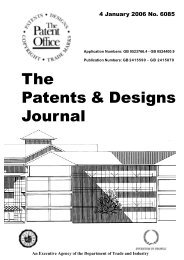Trade Mark Inter Partes Decision (O/189/12)
Trade Mark Inter Partes Decision (O/189/12)
Trade Mark Inter Partes Decision (O/189/12)
Create successful ePaper yourself
Turn your PDF publications into a flip-book with our unique Google optimized e-Paper software.
14. In his decision in La Chemise Lacoste SA v Baker Street Clothing Ltd - BL<br />
O/330/10 (approved by Arnold J in Och-Ziff Management Europe Ltd v Och Capital<br />
LLP [2011] FSR 11), the Appointed Person, Mr Geoffrey Hobbs QC, expressed the<br />
test under this section (by reference to the CJEU cases mentioned) on the basis<br />
indicated below:<br />
The CJEU cases<br />
Sabel BV v Puma AG [1998] RPC 199; Canon Kabushiki Kaisha v Metro-Goldwyn-<br />
Mayer Inc [1999] RPC 117; Lloyd Schuhfabrik Meyer & Co GmbH v Klijsen Handel<br />
B.V. [2000] F.S.R. 77; Marca Mode CV v Adidas AG & Adidas Benelux BV [2000]<br />
E.T.M.R. 723; Matratzen Concord GmbH v Office for Harmonisation in the <strong>Inter</strong>nal<br />
<strong>Mark</strong>et (<strong>Trade</strong> <strong>Mark</strong>s and Designs) (OHIM), Case T-6/01; Medion AG v. Thomson<br />
Multimedia Sales Germany & Austria GmbH C-<strong>12</strong>0/04; Shaker di L. Laudato & C.<br />
Sas v Office for Harmonisation in the <strong>Inter</strong>nal <strong>Mark</strong>et (<strong>Trade</strong> <strong>Mark</strong>s and Designs)<br />
(OHIM) C-334/05 P.<br />
The principles<br />
“(a) the likelihood of confusion must be appreciated globally, taking account of all<br />
relevant factors;<br />
(b) the matter must be judged through the eyes of the average consumer of the<br />
goods or services in question, who is deemed to be reasonably well informed and<br />
reasonably circumspect and observant, but who rarely has the chance to make direct<br />
comparisons between marks and must instead rely upon the imperfect picture of<br />
them he has kept in his mind, and whose attention varies according to the category<br />
of goods or services in question;<br />
(c) the average consumer normally perceives a mark as a whole and does not<br />
proceed to analyse its various details;<br />
(d) the visual, aural and conceptual similarities of the marks must normally be<br />
assessed by reference to the overall impressions created by the marks bearing in<br />
mind their distinctive and dominant components, but it is only when all other<br />
components of a complex mark are negligible that it is permissible to make the<br />
comparison solely on the basis of the dominant elements;<br />
(e) nevertheless, the overall impression conveyed to the public by a composite trade<br />
mark may, in certain circumstances, be dominated by one or more of its<br />
components;<br />
(f) and beyond the usual case, where the overall impression created by a mark<br />
depends heavily on the dominant features of the mark, it is quite possible that in a<br />
particular case an element corresponding to an earlier trade mark may retain an<br />
6




